Small, colorful, and brimming with curiosity, leopard geckos (Eublepharis macularius) are captivating creatures. They have taken over the hearts of reptile lovers all over the globe, and it’s easy to see why! These charming and gentle creatures are covered in striking patterns that allow them to blend into their surroundings. However, there’s more to leopard geckos than just their stellar good looks — they’re also super smart and social creatures! So, get ready to fall head over heels in love with these captivating creatures as we look at 10 adorable pictures and 10 amazing facts about baby leopard geckos!
1. Baby Leopard Gender Is Determined by Temperature
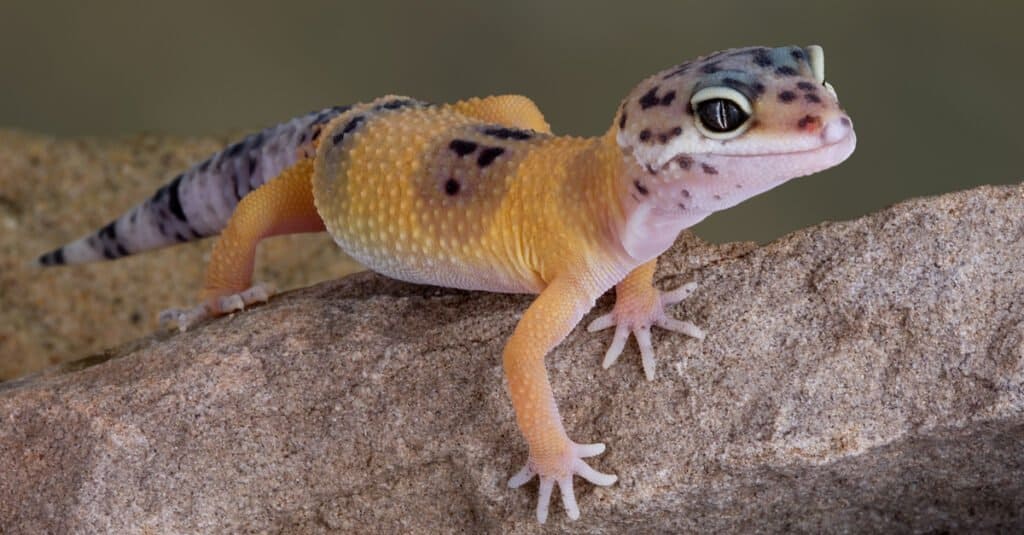
Baby leopard geckos are born with dark bands that eventually transition into spots.
©Cathy Keifer/Shutterstock.com
Many animals have two pairs of sex chromosomes: XX for females and XY for males. However, things are a little different for baby leopard geckos. Like many other reptiles, leopard geckos have temperature-dependent sex determination (TSD). This means that the Y chromosome doesn’t actually decide if a baby leopard gecko is going to be male or female. Instead, they have a gene called Dmrt1 that is in charge. This gene doesn’t activate when eggs incubate at cooler temperatures, so the baby leopard geckos develop into females. However, if the eggs incubate at warmer temperatures, the Dmrt1 gene causes the baby leopard geckos to develop into males.
In other words, if leopard gecko eggs incubate in an environment with cooler temperatures (around 80 to 85 degrees Fahrenheit), or extra warm temperatures (around 93 to 95 degrees Fahrenheit), the baby leopard geckos will develop as females. However, if the eggs incubate in an environment around 88 to 91 degrees Fahrenheit, the baby leopard geckos will develop as males. And if the incubation temperature stays somewhere in the middle, both female and male baby leopard geckos can develop!
2. Baby Leopard Geckos Use Tiny Egg Teeth to Hatch

Baby leopard geckos shed more frequently than adults do.
©Mufti Adi Utomo/Shutterstock.com
After mating, female leopard geckos can produce several clutches of eggs. Each clutch generally has two eggs, which incubate for 35 to 89 days. When the time comes, baby leopard geckos use a special tool to break out of their egg, called an “egg tooth”. The egg tooth is like a little pointy tip at the end of their snout that helps them crack open their shell. However, that is its only job — within one or two days after hatching, the egg tooth falls off!
Baby leopard gecko hatchlings are very small — just 3 to 4 inches long! It takes around 12 to 18 months for these tiny reptiles to fully develop. As adults, leopard geckos typically are 7 to 10 inches long and weigh 50 to 80 grams.
3. Baby Leopard Geckos Can’t Eat Until They Shed

Baby leopard geckos grow quickly in the first few months of life.
©forest warrior/Shutterstock.com
As you can probably imagine, hatching out of an egg takes a lot of energy. Baby leopard geckos spend the first 24 hours of life mostly resting until they are ready to shed. That’s right, a leopard gecko goes through its very first shed just 24 hours after it is born!
During this time, baby leopard geckos won’t eat anything because they are still soaking up all the goodness from their yolk sac. This yolk sac is like a little treasure trove of nutrients. Unfortunately, if they try to eat before they’ve completely absorbed all of the yolk sac, they will lack the important nourishment that they need in order to develop and grow.
4. Baby Leopard Geckos Don’t Have Sticky Toes, but They Can Still Climb
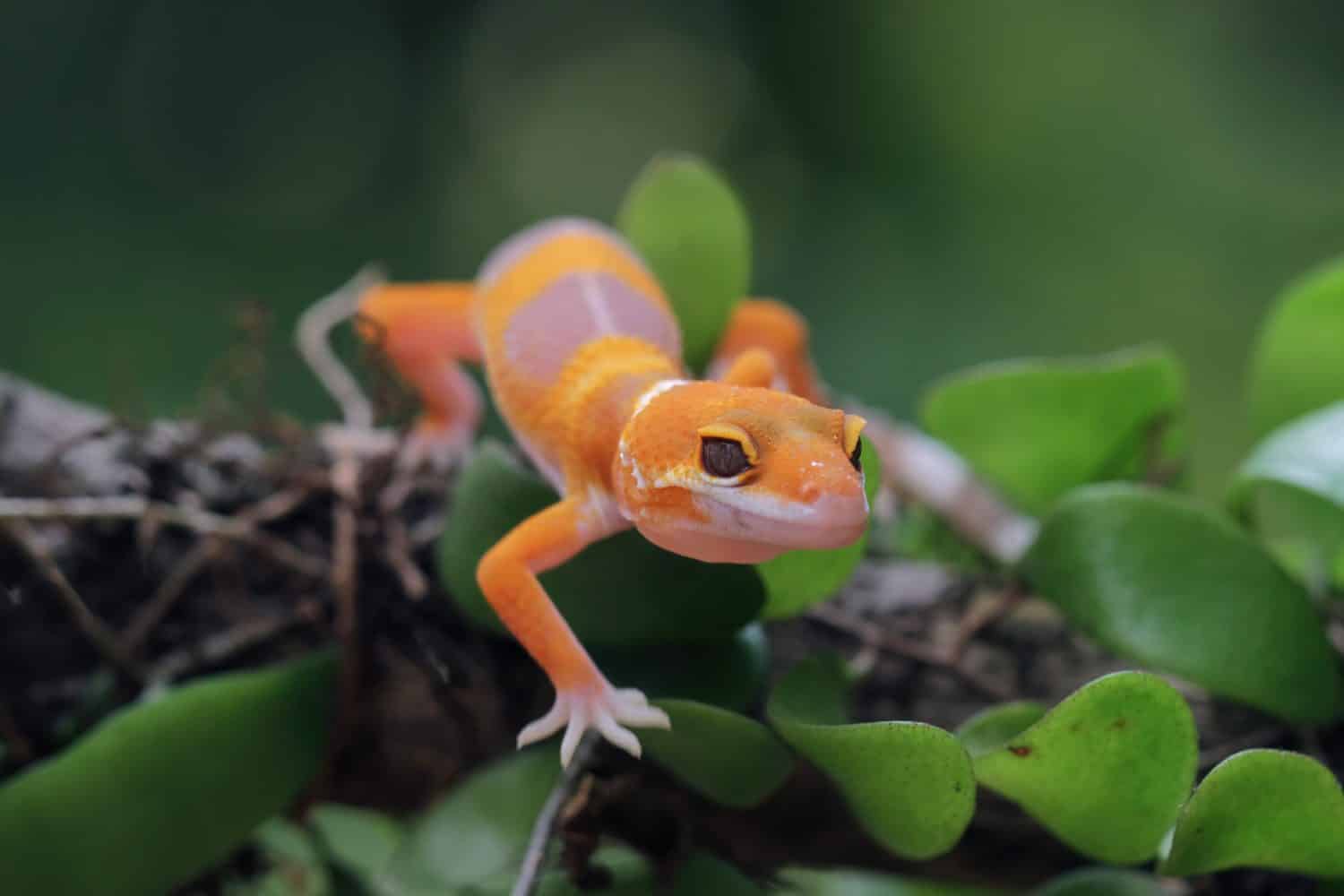
Baby leopard geckos have tiny claws on their toes.
©Agus_Gatam/Shutterstock.com
Many gecko species have adhesive lamallae on their toes, which is kind of like a bunch of tiny hairs that help them stick to smooth services. Using van der Waals force, the molecules on their toes attract the molecules on the surface of the wall, giving them the power to climb up it.
However, unlike geckos with sticky toes, baby leopard geckos instead have little claws that act like tiny grappling hooks! Leopard geckos are terrestrial animals and spend most of their time on the ground. They don’t have a need to climb tall trees or smooth rocks, but that doesn’t mean they can’t climb at all! In fact, their little claws are like built-in climbing gear, allowing baby leopard geckos to grip on to textured surfaces like rocks and branches. In addition, they help leopard geckos when digging and creating burrows in the sand.
5. Baby Leopard Geckos Have Voracious Appetites
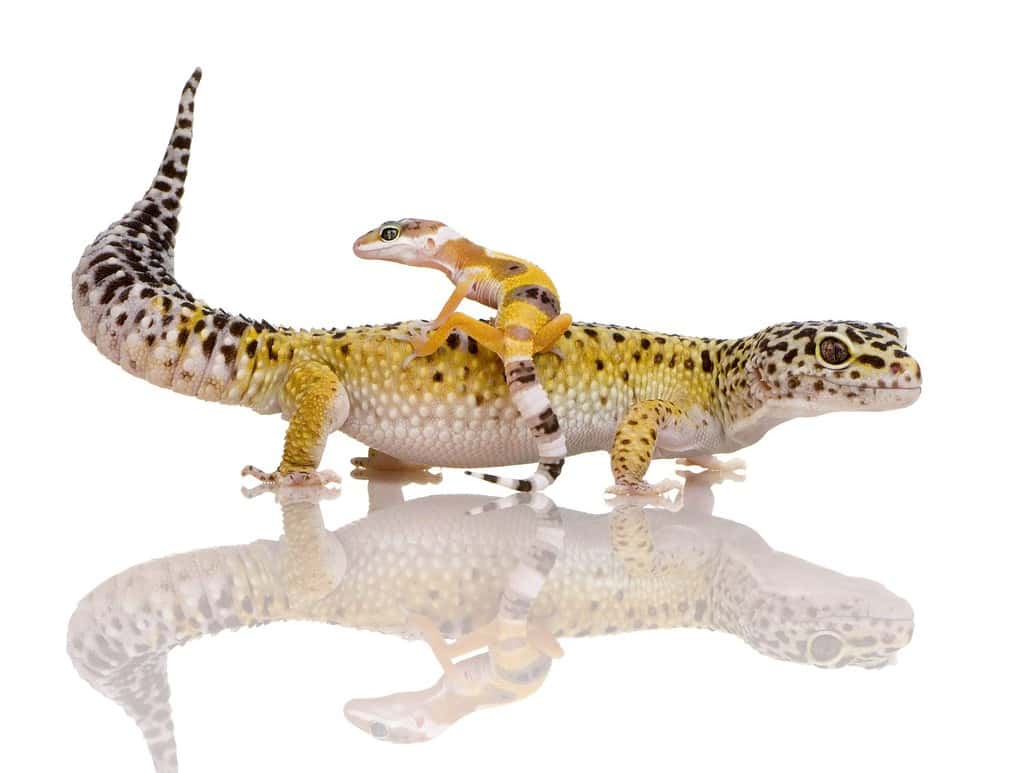
Baby leopard geckos need lots of food to help them grow into healthy adults.
©Eric Isselee/Shutterstock.com
As opportunistic predators, leopard geckos tend to eat whatever insects and invertebrates come their way. Adult leopard geckos should eat every other day to avoid obesity and other health problems. However, baby leopard geckos are small and still need lots of nourishment to grow. They need to eat every day in order to get enough nutrients and energy for their developing bodies.
But unlike their adult counterparts, baby leopard geckos have a much more restrictive diet due to their small size. If they eat food that is too big for them, it can lead to impaction or choking. A baby leopard gecko should not eat anything bigger than the space between its eyes. For young babies, that often means small, soft crickets rather than larger, tougher animals like mealworms.
6. Baby Leopard Geckos Store Fat in Their Tails
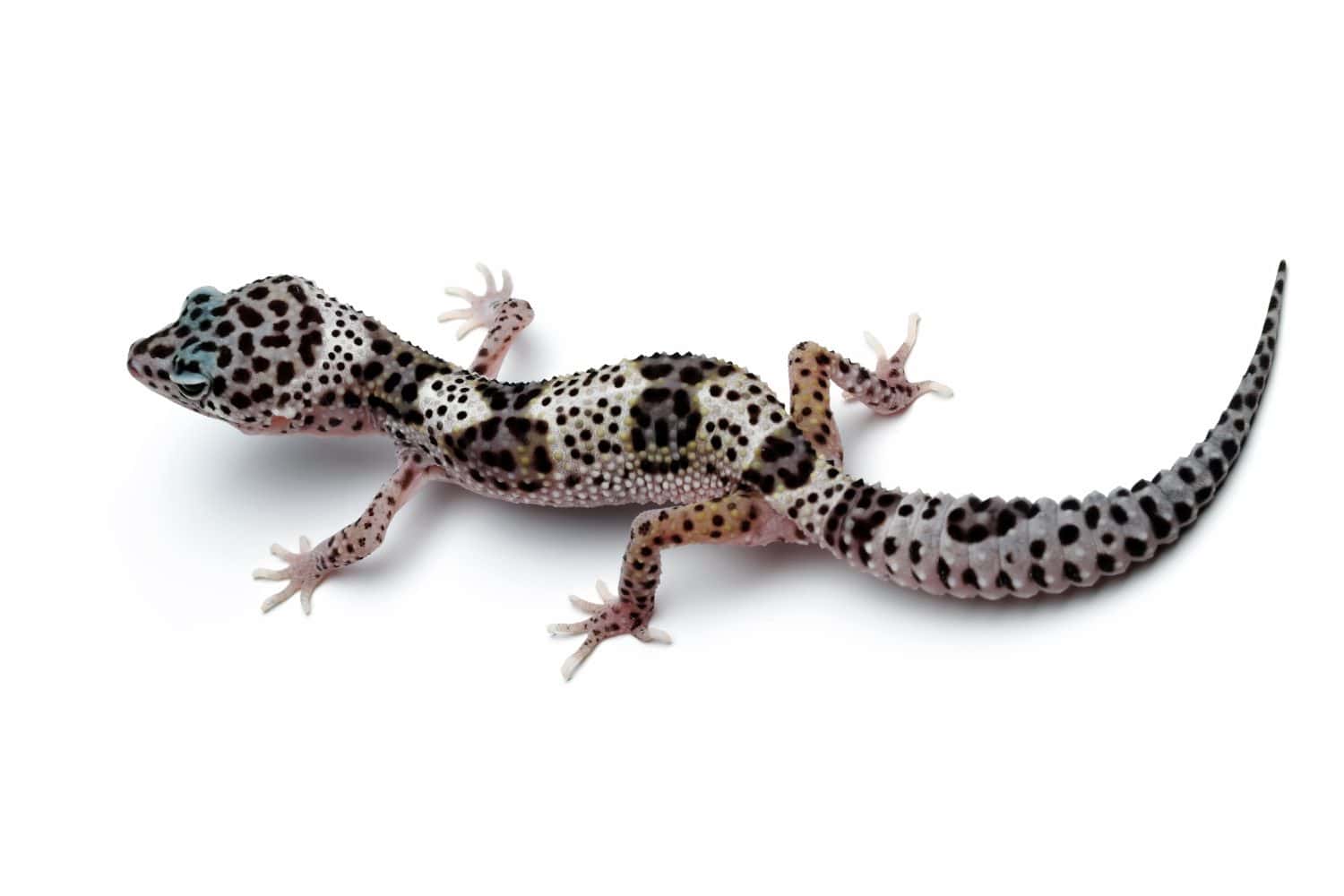
Leopard geckos need adequate humidity to properly shed.
©Agus_Gatam/Shutterstock.com
You might notice that some leopard geckos have thicker tails than others. Similar to how camels use their humps to store fat, baby leopard geckos use their tails as their own built-in energy reserves, kind of like having a secret snack stash! When there’s not enough food around for these little geckos, they can tap into the fat stored in their tails for backup.
You can often tell if a leopard gecko is eating too much or too little based on the condition of its tail. If the tail is straight and thin, then the leopard gecko isn’t getting enough to eat. However, if the tail is thicker than the gecko’s neck, it might be time to cut back on the late-night snacks.
7. Baby Leopard Geckos Wag Their Tails and Make Some Pretty Awesome Sounds

Baby leopard geckos tend to make noises more often than adults do.
©Spok83/Shutterstock.com
Just like humans, baby leopard geckos express their feelings and emotions through movement and various noises. When baby leopard geckos hunt, for example, they lift their tails in a quick twitching or wave-like motion, which makes them look like tiny reptilian dogs wagging their tails! Leopard geckos do this when they get close to their prey, signaling that they are ready to pounce. Once a baby leopard gecko finishes eating, it returns its tail back to the relaxed position.
Although they typically aren’t very vocal, baby leopard geckos can also make a variety of sounds to express how they are feeling. Chirping and squeaking, for example, can mean that a baby leopard gecko is happy. Clicking typically means that they are uncomfortable, stressed, or annoyed. If they are feeling especially threatened or in direct danger, however, leopard geckos will resort to barking. The least common sound baby geckos make but perhaps the most startling is a scream. Screaming is a key sign that a baby leopard gecko is scared or in danger. When a baby leopard gecko screams, it sounds like a tiny little dinosaur!
8. Baby Leopard Geckos Can Grow New Tails
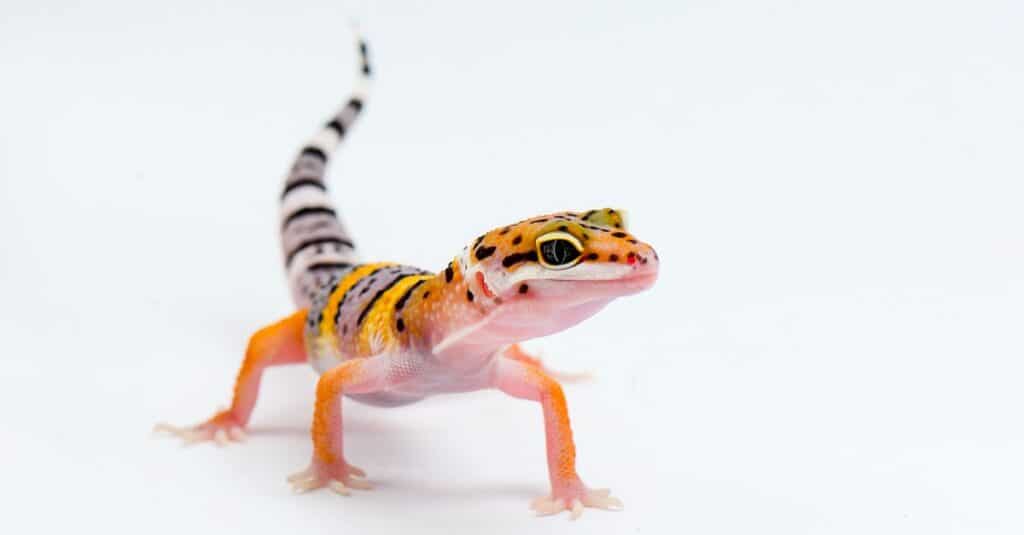
Regenerated tails are shorter and fatter than original tails.
©DWI YULIANTO/Shutterstock.com
Another amazing fact about baby leopard geckos is that when they feel direct danger, they can purposely pop their tails off! The ability to voluntarily detach a tail is called caudal autotomy. It is a remarkable adaptation that allows leopard geckos to sever their own tail as a defense when they are under attack. When threatened, their bodies experience rapid vasoconstriction, causing the blood vessels in the tail to constrict or narrow, which reduces bleeding if a baby gecko chooses to sever its tail. A detached tail is a clever defensive distraction, as it can keep twitching as if alive for up to 30 minutes! This buys time for the baby gecko to escape.
However, this defense mechanism does come with a price. When baby leopard geckos detach their tails, they lose all the fat stored in them. As a result, baby leopard geckos do not casually shed their tails — life without a tail is extremely stressful! Although they can grow another one, the new regenerated tail never looks quite like the original. It may have similar colors, but it’s usually shorter, fatter, and smoother.
9. Baby Leopard Geckos Can Be Great Pets
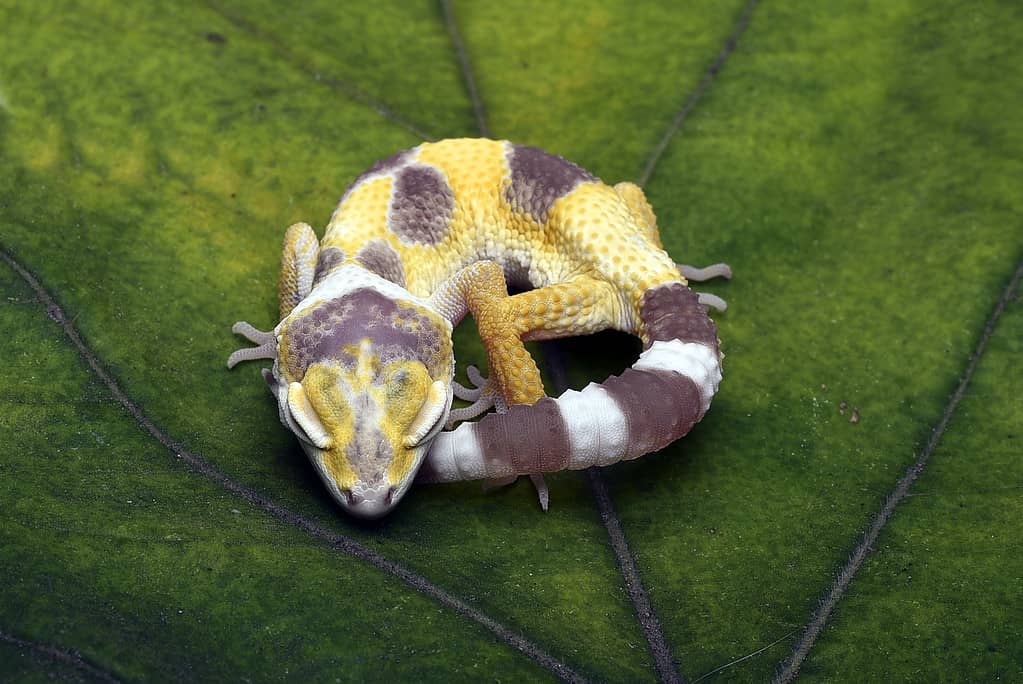
Spending time with your baby gecko helps them in getting used to humans.
©DikkyOesin/iStock via Getty Images
Over the past several decades, baby leopard geckos have become one of the most popular reptiles in the pet world. They are not quite as demanding as many other reptiles and are generally pretty resilient. Leopard geckos don’t need a ton of space and their diet mainly consists of insects. However, they do have their own specific needs and requirements, so it’s important to do your homework and set up the perfect home if you’re planning on getting a baby leopard gecko — complete with the proper habitat, food, and enrichment. In addition, leopard geckos are a long-term commitment, as they can live 10 to 20 years.
Baby leopard geckos have amazing personalities and are not aggressive. In fact, with plenty of patience and dedication, you can help your baby leopard gecko become accustomed to humans and even handling. Leopard geckos can be so gentle and easygoing that you can train them to eat from your hand or snuggle up on your arm.
10. Baby Leopard Geckos Come In Almost Every Color of the Rainbow

Baby leopard geckos are skittish and stress easily.
©Pepi M Firmansyah/Shutterstock.com
In the wild, leopard geckos are typically yellow with black or dark brown spotted patterns like a leopard. Baby leopard geckos, however, are born with thick bands of color. These slowly transition into spots as they grow and mature. The coloration of leopard geckos provides excellent camouflage in their arid and semi-arid habitats in Asia and the Middle East.
In captivity, leopard gecko breeders use selective breeding to produce a variety of color morphs. For example, albino leopard geckos lack color while melanistic, black night, and black pearl leopard geckos appear almost completely black from head to toe. Blizzard geckos have black eyes and solid colors of yellow, white, or purple. Tangerine leopard geckos have beautiful, bright orange tails, and lavender leopard geckos are a lovely light purple with spots or stripes. As of 2023, there are more than 100 leopard gecko color morphs. The rarer the morph, the more expensive, however. Fun fact: some baby leopard gecko morphs can cost thousands of dollars!
The photo featured at the top of this post is © Spok83/Shutterstock.com
Thank you for reading! Have some feedback for us? Contact the AZ Animals editorial team.






